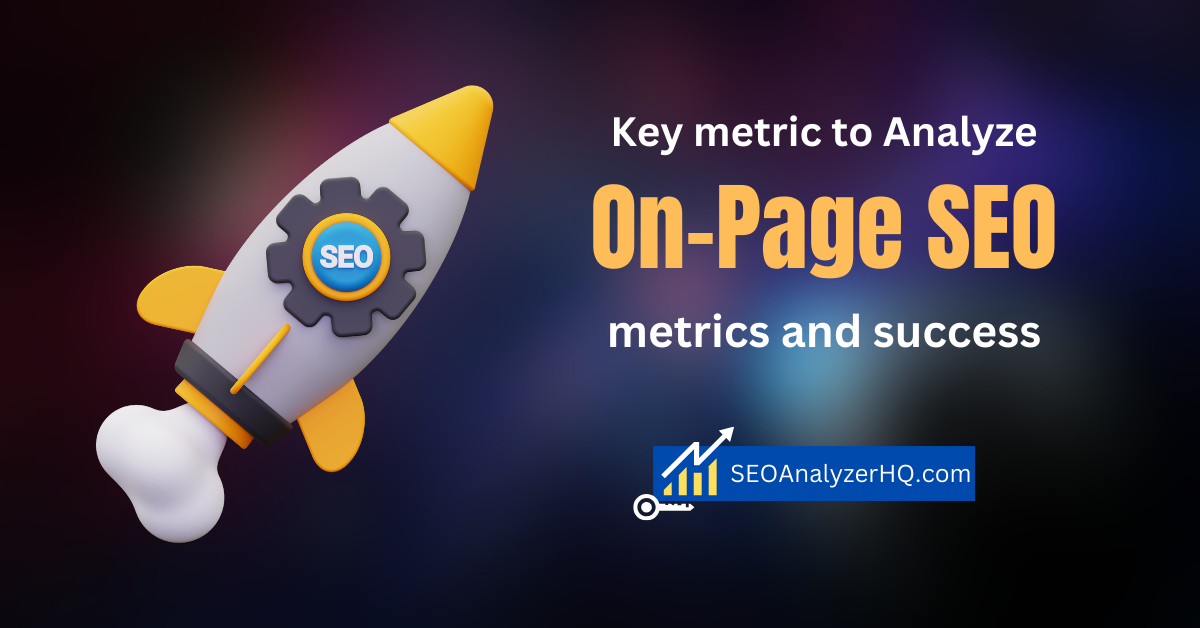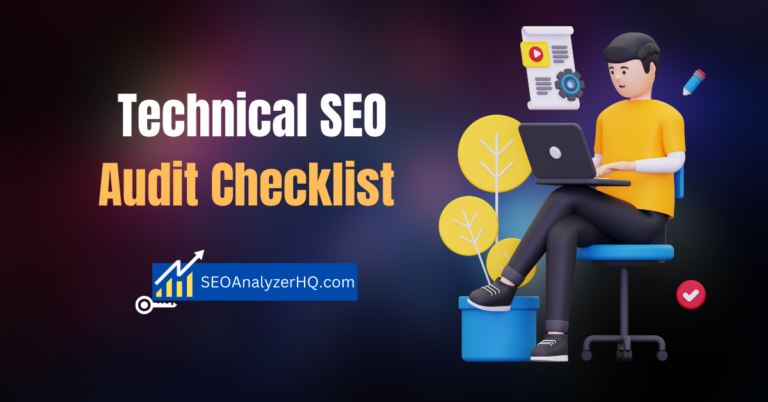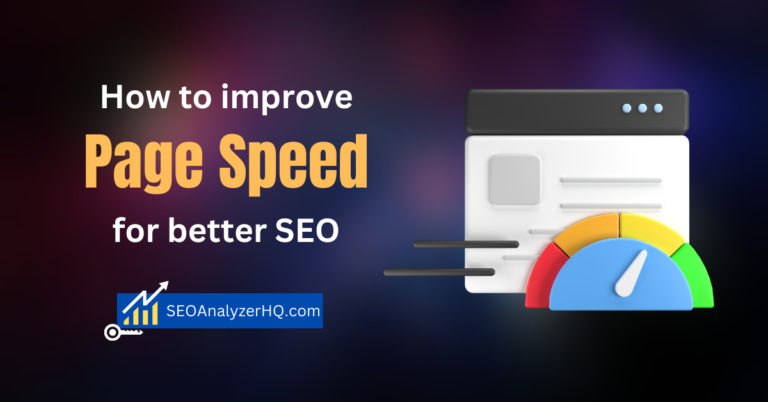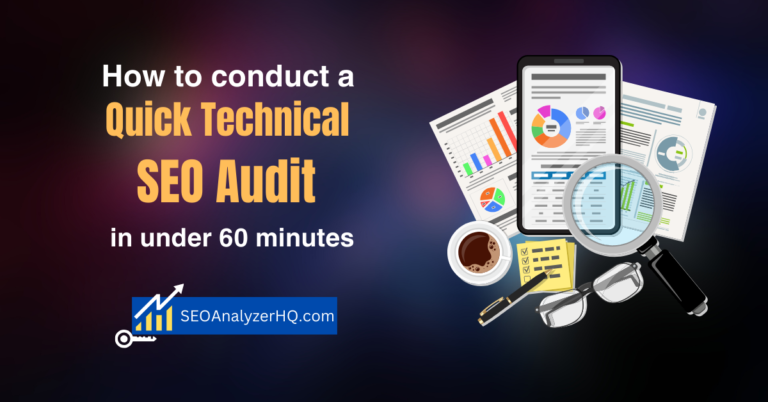On-Page SEO Metrics: Key Performance Indicators for SEO Success

Tracking the right on-page SEO metrics is essential to improving your website’s visibility and ranking on search engines. These metrics provide valuable insights into how well your content and site structure are optimized for SEO. In this guide, we’ll dive into the most critical on-page SEO metrics you should be monitoring to ensure your website is set up for long-term success.
What Are On-Page SEO Metrics?
On-page SEO metrics refer to measurable data points that provide insights into the effectiveness of your website’s content and SEO strategies. These metrics help you evaluate factors such as page load time, keyword optimization, content quality, and user engagement.
Understanding and tracking these metrics is crucial to improving your website’s search engine performance and user experience.
Key Metrics to Track for On-Page SEO Success
1. Organic Traffic
Organic traffic is one of the most important on-page SEO metrics to monitor. It represents the number of visitors who come to your website through unpaid search engine results. A steady increase in organic traffic indicates that your on-page SEO efforts are paying off.
To track organic traffic:
- Use Google Analytics or other web analytics tools
- Monitor the trend over time
- Compare traffic from different search engines
- Analyze traffic by landing page to identify top-performing content
- Why it’s important: Organic traffic is a direct indicator of how well your site is ranking in search engine results. More organic traffic means better visibility.
- How to track it: Use tools like Google Analytics to monitor traffic trends and identify your highest-performing pages.
2. Bounce Rate
Bounce rate represents the percentage of visitors who leave your website after viewing only one page. A high bounce rate may indicate that your content doesn’t meet user expectations or that your page load speed is slow. Bounce rate measures the percentage of visitors who leave your website after viewing only one page.
To reduce bounce rate:
- Ensure content relevance and quality
- Improve page load speed
- Optimize website navigation
- Use internal linking to encourage further exploration
- Why it’s important: A high bounce rate can indicate poor user experience or irrelevant content.
- How to improve: Focus on creating engaging, high-quality content and ensure your site has a clear call-to-action to reduce bounce rates.
3. Page Load Speed
Page load speed is a critical on-page SEO metric that affects both user experience and search engine rankings. Faster-loading pages tend to perform better in search results and have lower bounce rates. Page load speed is the time it takes for a webpage to fully load in a browser.
To improve page load speed:
- Optimize images and other media files
- Minimize HTTP requests
- Enable browser caching
- Use a content delivery network (CDN)
- Why it’s important: Slow loading times can negatively impact user experience and search rankings. Google considers page speed as a ranking factor.
- How to track it: Use tools like Google PageSpeed Insights to monitor and optimize page load times.
4. Average Time on Page
This metric measures how long users spend on your web pages, on average. A higher average time on page suggests that visitors find your content engaging and valuable. This metric measures how long, on average, users stay on a particular page.
To increase average time on page:
- Create high-quality, in-depth content
- Use multimedia elements (images, videos, infographics)
- Improve readability with proper formatting
- Implement internal linking to related content
- Why it’s important: A longer average time on page suggests that visitors find your content valuable and engaging.
- How to improve: Focus on creating comprehensive, informative, and engaging content that keeps users on the page longer.
5. Keyword Rankings
Tracking your keyword rankings helps you understand how well your pages are performing for specific search terms. Improved rankings often lead to increased organic traffic and visibility. Tracking keyword rankings helps you see where your pages are ranking for specific target keywords.
Key aspects of keyword ranking metrics:
- Track rankings for target keywords
- Monitor changes in rankings over time
- Identify keywords with potential for improvement
- Analyze competitor rankings for the same keywords
- Why it’s important: Monitoring keyword performance allows you to assess whether your SEO strategies are working and which keywords need more optimization.
- How to track it: Use tools like Ahrefs or SEMrush to track changes in your keyword rankings over time.
6. Click-Through Rate (CTR)
CTR measures the percentage of users who click on your search result after seeing it in the SERPs. A higher CTR indicates that your title tags and meta descriptions are effectively attracting users’ attention. Click-through rate measures the percentage of users who click on your site after seeing it in search engine results.
To improve CTR:
- Optimize title tags and meta descriptions
- Use compelling and relevant copy
- Include target keywords naturally
- Leverage structured data to enhance search snippets
- Why it’s important: A low CTR might indicate that your title tags and meta descriptions aren’t compelling enough to attract clicks.
- How to improve: Optimize your title tags and meta descriptions to better match user intent and increase CTR.
7. Internal Linking Structure
Internal linking plays a crucial role in distributing page authority and helping users navigate your site. Internal links help users navigate your site and provide search engines with clues about the importance of certain pages.
Monitor these internal linking metrics:
- Number of internal links per page
- Distribution of internal links across the site
- Click-through rates on internal links
- Orphaned pages (pages with no internal links)
- Why it’s important: A good internal linking structure improves user experience and helps distribute link equity across your site, which can improve rankings.
- How to track it: Regularly audit your site’s internal links to ensure they are pointing to relevant content and follow a logical structure.
8. Mobile-Friendliness
With mobile searches accounting for a significant portion of overall search traffic, mobile-friendliness is a crucial on-page SEO metric. Google’s mobile-first indexing means that the mobile version of your site is prioritized for indexing and ranking. With more users browsing the web on mobile devices, mobile-friendliness has become a critical ranking factor.
To enhance mobile-friendliness:
- Use responsive design
- Optimize images and media for mobile devices
- Improve touch-friendly navigation
- Ensure readable font sizes on small screens
- Why it’s important: Google uses mobile-first indexing, meaning the mobile version of your site is used to determine rankings.
- How to track it: Use Google’s Mobile-Friendly Test to ensure your site is optimized for mobile users.
9. Content Readability
Content readability measures how easy your content is to read and understand.
- Why it’s important: Search engines favor content that is easy to digest and relevant to the user. Readable content improves user engagement.
- How to improve: Break up long blocks of text, use bullet points, and write in short sentences to enhance readability.
10. Core Web Vitals
Core Web Vitals are a set of specific factors that Google considers important in a webpage’s overall user experience. Core Web Vitals are a set of metrics introduced by Google to measure page experience, including Largest Contentful Paint (LCP), First Input Delay (FID), and Cumulative Layout Shift (CLS).
These metrics include:
- Largest Contentful Paint (LCP): measures loading performance
- First Input Delay (FID): measures interactivity
- Cumulative Layout Shift (CLS): measures visual stability
Monitor these metrics using Google Search Console and PageSpeed Insights to ensure your pages provide a good user experience.
- Why it’s important: Core Web Vitals impact user experience, and poor performance in these areas can negatively affect your rankings.
- How to track it: Google Search Console provides a dedicated report for Core Web Vitals that shows where your site needs improvement.
11. Crawl Errors
Crawl errors occur when search engine bots encounter issues while trying to access and index your web pages. Monitoring and resolving these errors is essential for maintaining good on-page SEO.
Common types of crawl errors:
- 404 (Not Found) errors
- 5xx Server errors
- DNS errors
- Robots.txt errors
Use Google Search Console or other SEO tools to identify and fix crawl errors promptly.
12. Page Depth
Page depth refers to the number of clicks required to reach a specific page from the homepage. Pages that are closer to the homepage (lower page depth) tend to have more authority and better visibility in search results.
To optimize page depth:
- Implement a clear and logical site structure
- Use internal linking strategically
- Create a comprehensive sitemap
- Ensure important pages are easily accessible
13. Organic Conversion Rate
Organic conversion rate measures the percentage of organic visitors who complete a desired action on your website, such as making a purchase or filling out a contact form. This metric helps you assess the effectiveness of your on-page SEO in driving valuable user actions.
To improve organic conversion rate:
- Align content with user intent
- Optimize landing pages for conversions
- Use clear and compelling calls-to-action (CTAs)
- Implement A/B testing to refine your approach
14. Schema Markup Implementation
Schema markup helps search engines understand the context and structure of your content, potentially leading to rich snippets in search results. While not a direct ranking factor, schema markup can improve click-through rates and visibility.
Key schema markup metrics to track:
- Number of pages with implemented schema
- Types of schema used (e.g., Article, Product, FAQ)
- Rich snippet appearance in search results
15. HTTPS Usage
HTTPS is a ranking factor and an important aspect of website security. Track the following metrics related to HTTPS:
- Percentage of pages served over HTTPS
- SSL certificate validity and expiration
- Mixed content issues (HTTP resources on HTTPS pages)
Tools for Tracking On-Page SEO Metrics
To effectively monitor and analyze these on-page SEO metrics, consider using a combination of the following tools:
This section is crucial because having the right tools can significantly enhance your ability to monitor and improve your on-page SEO efforts.
Let’s break down each tool and its specific uses:
1. Google Analytics
Google Analytics is a free, powerful web analytics service offered by Google. It’s essential for tracking various aspects of your website’s performance, including:
- Organic traffic: See how many visitors come to your site from search engines
- Bounce rate: Understand the percentage of single-page visits
- User behavior: Analyze how visitors interact with your site, including page views, session duration, and navigation paths
- Conversion tracking: Set up goals to track important actions on your site
Google Analytics also provides demographic information about your audience and can help you identify which pages are most popular or have the highest exit rates.
2. Google Search Console
Another free tool from Google, Search Console is specifically designed for monitoring your site’s presence in Google Search results. Key features include:
- Keyword rankings: See which queries your site appears for in search results
- Crawl errors: Identify pages that Google’s bots have trouble accessing
- Core Web Vitals: Monitor these important user experience metrics
- Index coverage: Ensure all your important pages are being indexed by Google
- Mobile usability: Check if your pages are mobile-friendly
Google Search Console also allows you to submit sitemaps and individual URLs for indexing, making it a vital tool for managing your site’s visibility in search results.
3. SEMrush or Ahrefs
These are paid tools that offer comprehensive SEO analysis capabilities. While they have some overlapping features, they’re particularly useful for:
- Keyword research: Find new keyword opportunities and analyze their difficulty
- Competitor analysis: See what keywords your competitors are ranking for
- Backlink analysis: Understand your site’s link profile and find new link opportunities
- Content gap analysis: Identify topics you’re not covering that your competitors are
- Position tracking: Monitor your rankings for specific keywords over time
These tools can provide deeper insights into your SEO performance and help you develop strategies to outperform competitors.
4. Screaming Frog
Screaming Frog SEO Spider is a website crawling tool that allows you to analyze your site from an SEO perspective. It’s particularly useful for:
- Technical SEO audits: Identify issues like broken links, duplicate content, or missing meta tags
- Internal linking analysis: Understand how your site’s pages are connected
- XML sitemap generation: Create sitemaps for submission to search engines
- Finding redirect chains: Identify and fix long redirect chains that can slow down your site
Screaming Frog offers a free version with limited capabilities and a paid version for more extensive crawling.
5. PageSpeed Insights
This free tool from Google focuses on page performance. It provides:
- Page load speed analysis: Get detailed metrics on how quickly your pages load
- Core Web Vitals assessment: See how your pages perform on these critical user experience metrics
- Optimization suggestions: Receive specific recommendations for improving page speed
PageSpeed Insights analyzes both mobile and desktop versions of your pages, which is crucial given Google’s mobile-first indexing.
6. Yoast SEO (for WordPress)
If your site runs on WordPress, Yoast SEO is a popular plugin that helps with on-page optimization. Its features include:
- Content analysis: Get real-time feedback on your content’s SEO-friendliness
- Readability checks: Ensure your content is easy to read and understand
- Meta tag and XML sitemap generation: Automatically create important SEO elements
- Social media integration: Control how your content appears when shared on social platforms
While Yoast SEO is specific to WordPress, it’s an excellent tool for streamlining on-page SEO tasks for this popular CMS.
Using a combination of these tools allows you to get a comprehensive view of your on-page SEO performance. Each tool has its strengths, and together they can provide insights into nearly every aspect of your on-page SEO efforts.
Remember, while these tools are powerful, they’re most effective when used as part of a well-planned SEO strategy. The insights they provide should inform your decisions, but your expertise and understanding of your specific audience and business goals are equally important in shaping your SEO approach.
Implementing an On-Page SEO Metrics Tracking Strategy
To make the most of these on-page SEO metrics, follow these steps:
1. Set clear goals and KPIs for your on-page SEO efforts
- Use SMART criteria: Specific, Measurable, Achievable, Relevant, and Time-bound
- Examples:
- Increase organic traffic by 20% in the next 6 months
- Improve average position for target keywords from 15 to 10 in 3 months
- Reduce bounce rate from 65% to 55% in 4 months
2. Choose the most relevant metrics based on your goals
- For increasing organic traffic:
- Overall organic sessions
- Landing page traffic
- Keyword rankings
- For improving user engagement:
- Bounce rate
- Average time on page
- Pages per session
- For conversion-focused goals:
- Conversion rates
- Goal completions
- Assisted conversions
3. Establish a regular reporting schedule
- Weekly: Quick check on core metrics (traffic, rankings)
- Monthly: Comprehensive review of all relevant metrics
- Quarterly: In-depth analysis of trends and progress towards annual goals
4. Use data visualization tools to create easy-to-understand reports
- Utilize tools like Google Data Studio
- Create charts and graphs to illustrate trends
- Use heat maps to visualize user behavior
5. Analyze trends and patterns in your metrics over time
- Identify seasonal patterns
- Look for correlations between different metrics
- Compare year-over-year data
6. Identify areas for improvement and prioritize optimization efforts
- List all potential improvements
- Prioritize based on potential impact and required effort
- Create a roadmap for implementation
7. Implement changes based on your findings
- Make one change at a time when possible
- Document changes and their timing
- Be prepared to roll back ineffective changes
8. Continuously monitor and adjust your strategy as needed
- Regularly revisit and adjust goals
- Stay informed about SEO best practices and algorithm changes
- Be ready to pivot strategy based on new data or business needs
Additional Considerations
- Keep stakeholders informed through regular reporting
- Embrace a test-and-learn approach
- Maintain flexibility in your strategy
- Focus on enhancing user experience
By following these steps, you create a structured, data-driven approach to improving your on-page SEO, allowing for continuous improvement and demonstrable value.
Final words onOn-Page SEO metrics and performance
Monitoring these essential on-page SEO metrics can provide critical insights into how well your website is optimized for search engines and user experience. By keeping an eye on these key metrics and making data-driven improvements, you can boost your search rankings and drive more organic traffic to your site. Start tracking these metrics today and watch your SEO performance soar!
Frequently Asked Questions (FAQs)
Why is page load speed important for on-page SEO?
Page load speed is a crucial ranking factor because slow pages lead to poor user experiences. Google rewards faster pages with better rankings.
What is bounce rate, and how can I reduce it?
Bounce rate measures the percentage of visitors who leave after viewing only one page. You can reduce it by improving content relevance, using clear CTAs, and enhancing the overall user experience.
How do keyword rankings impact SEO?
Keyword rankings show how well your content is optimized for specific search terms. Higher rankings mean more organic traffic, so tracking and improving keyword performance is essential for SEO success.
What are Core Web Vitals, and why do they matter?
Core Web Vitals are a set of performance metrics introduced by Google that measure aspects of user experience like load time, interactivity, and visual stability. They are important ranking factors.
How can I improve my click-through rate (CTR)?
To improve CTR, ensure your title tags and meta descriptions are engaging, relevant, and optimized with the right keywords. Make them attractive to users searching for specific queries.





